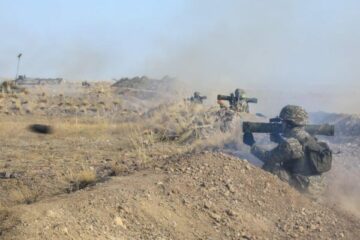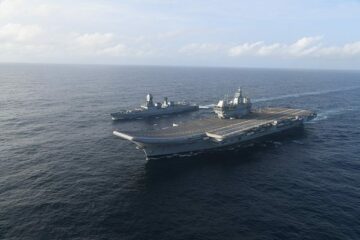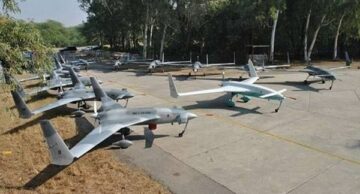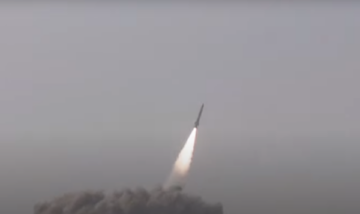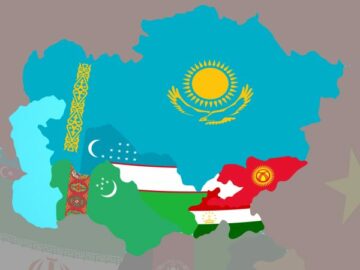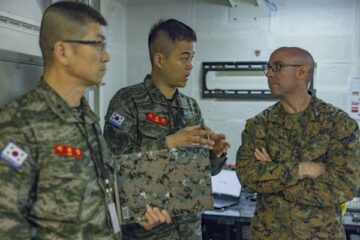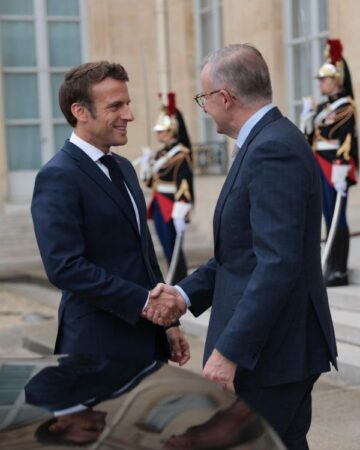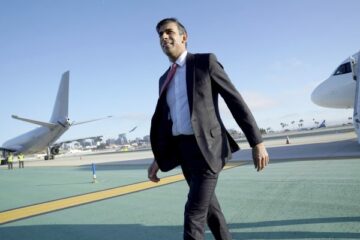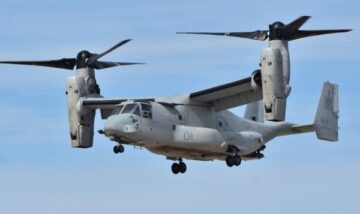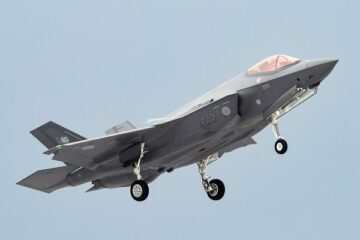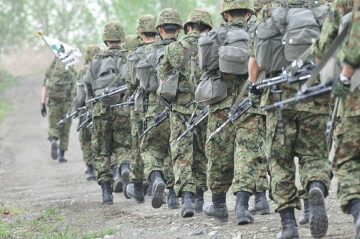
After wide-ranging talks on bilateral, regional, and international issues in Washington, U.S. President Joe Biden and Japanese Prime Minister Kishida Fumio have agreed to deepen and widen defense and security cooperation as “Global Partners for the Future.” In doing so, the allies plan to counter China’s forceful maritime expansion, North Korea’s rapid nuclear and missile development, and Russia’s unprovoked and illegal aggression against Ukraine.
At the Japan-U.S. summit on April 10, the two leaders pledged to advance cooperation in areas ranging from artificial intelligence and quantum technology to semiconductors, space, and biotechnology.
Although they unveiled more than 70 programs and initiatives including a wide array of critical advanced technological sectors, security was their number one agenda.
Most notably, they announced plans to bilaterally upgrade the command-and-control framework to better coordinate Japan’s Self-Defense Forces (SDF) and U.S. forces stationed in Japan.
To face regional security challenges, “we announce our intention to bilaterally upgrade our respective command and control frameworks to enable seamless integration of operations and capabilities and allow for greater interoperability and planning between U.S. and Japanese forces in peacetime and during contingencies,” said a joint leaders’ statement issued after their meeting.
“More effective U.S.-Japan Alliance command and control will strengthen deterrence and promote a free and open Indo-Pacific in the face of pressing regional security challenges,” the statement added.
By emphasizing seamless integrated operations, the two nations aim to respond to any situations from peacetime to gray zone coercion and regional emergencies. Behind this move is China’s gray-zone strategy, which makes use of diverse military and non-military measures and blurs the boundaries of peace and conflict.
As for the Japanese side, Tokyo plans to establish a permanent joint operations command to oversee the ground, maritime and air branches of the SDF by March 2025, with an initial staff of 240 personal.
There has been a growing awareness of the need for this command for years especially after the 2011 Tohoku Earthquake, or the triple tragedy of the earthquake, tsunami, and nuclear accident. Back then, the chief of staff of the Joint Staff was so busy reporting to the Prime Minister’s Office that he could not pay close attention to SDF operations, although he was the top uniformed officer.
Viewed in a historical context, bad relations and cultural chasms between Imperial Japanese Army and Navy before and during World War II have also prevented the establishment of such a joint command until now.
As for the U.S. side, U.S. Forces Japan, the command headquartered at Tokyo’s Yokota base, is currently tasked mainly with managing bases and personnel. It is not authorized to direct operations in response to regional emergencies.
Instead, the U.S. Indo-Pacific Command, headquartered in the U.S. state of Hawaii, has authority over U.S. Forces Japan. For example, Pacific Air Forces, headquartered at Joint Base Pearl Harbor-Hickam, Hawaii, is home to the 5th Air Force at Yokota Air Base. Meanwhile, the III Marine Expeditionary Force, the U.S. Marines’ forward-deployed presence in Okinawa, Japan, is under the U.S. Marine Corps Forces, Pacific in Hawaii.
Tokyo and Hawaii are about 6,500 kilometers apart and have a time difference of 19 hours. This makes it difficult to coordinate operations and share information between the Japanese and U.S. forces in real time.
Japan has long wanted a new U.S. joint operational command in Tokyo, as it has to heavily rely on the U.S. military’s intelligence, surveillance, and reconnaissance (ISR) capabilities in times of emergency – whether a Taiwan contingency or one involving the disputed Senkaku/Diaoyu Islands, which Japan administers but China claims.
But this time Biden and Kishida didn’t go so far as to integrate command-and-control authorities of the SDF and U.S. forces in an emergency.
For example, in the South Korea-U.S. alliance, there is a U.S.-ROK Combined Forces Command (CFC), and the American commander of the CFC has command authority (operational control) over the U.S.-ROK Combined Forces, which consists of U.S. Forces Korea and South Korean forces, in an emergency. The American commander also holds the posts of commander of the United Nations Forces Korea and commander of U.S. Forces Korea.
Militarily speaking, it would be more efficient for combined operations between allied countries to be conducted under a single allied commander. However, in the past in Tokyo, there have been some disputes over the nature of command in the Japan-U.S. alliance. The United States initially demanded that Japan unify its command by having the SDF come under the command of the U.S. military in emergencies.
For example, on July 23, 1952, immediately after the U.S. occupation of Japan ended, a secret oral agreement was reached between then-Japanese Prime Minister Yoshida Shigeru and U.S. Far East Command Commander Mark Clark, under which the United States would take command in the event of an emergency.
After a period of uncertainty regarding the effectiveness of this secret command agreement, in 1978 when the old Guidelines for Japan-U.S. Defense Cooperation were drawn up, Japan rejected the U.S. authority to command in an emergency, and it became clear that command authority would be parallelized from then on.
This is mainly because under Japan’s pacifist constitution, the right of belligerency is renounced and the SDF are not recognized as a military force. This makes the integration of command-and-control authorities of the SDF and U.S. forces difficult. Moreover, there has been a deep-rooted view among the Japanese that it is dangerous to become involved in any American war via the integration of command-and-control authorities between the SDF and U.S. Forces Japan in times of emergency, such as a Korean Peninsula crisis.
To put it simply, command and control is a critical issue of Japan’s sovereignty.
As if to confirm Japan’s official stance on the juxtaposition of command authority between the two nations, Chief Cabinet Secretary Hayashi Yoshimasa said on April 11 that the SDF’s joint operations command to be established in fiscal year 2024 will not come under command and control of the U.S. military.
“The SDF and the U.S military act independently under their respective command and control systems,” the top government spokesman told a press conference.
Still, as tensions between China and Taiwan have risen in recent years, so have calls in Tokyo and Washington for closer coordination between the SDF and the U.S. military. For example, in a panel discussion at a CSIS/Nikkei Symposium in Tokyo on October 21, 2022, Gary Roughead, the former U.S. Navy chief of naval operations, said a combined Japan-U.S. military headquarters could function as a “standalone” entity in guiding operations in the Indo-Pacific.
Although the Kishida administration denies the integration of command-and-control authorities of SDF and U.S. forces in an emergency, this issue will likely linger in coming years, especially on the U.S. side.
- SEO Powered Content & PR Distribution. Get Amplified Today.
- PlatoData.Network Vertical Generative Ai. Empower Yourself. Access Here.
- PlatoAiStream. Web3 Intelligence. Knowledge Amplified. Access Here.
- PlatoESG. Carbon, CleanTech, Energy, Environment, Solar, Waste Management. Access Here.
- PlatoHealth. Biotech and Clinical Trials Intelligence. Access Here.
- Source: https://thediplomat.com/2024/04/deeper-and-wider-defense-integration-tops-japan-us-summit-agenda/
- :has
- :is
- :not
- $UP
- 10
- 11
- 19
- 2011
- 2022
- 2024
- 2025
- 21
- 23
- 500
- 5th
- 6
- 70
- a
- About
- accident
- Act
- added
- administration
- advance
- advanced
- After
- against
- agenda
- agreed
- Agreement
- aim
- AIR
- Air Force
- Alliance
- allow
- also
- Although
- American
- among
- an
- and
- Announce
- announced
- any
- apart
- April
- ARE
- areas
- Army
- Array
- artificial
- artificial intelligence
- AS
- At
- attention
- Authorities
- authority
- authorized
- awareness
- back
- Bad
- base
- BE
- became
- because
- become
- been
- before
- behind
- Better
- between
- biden
- bilateral
- biotechnology
- Blurs
- boundaries
- branches
- busy
- but
- by
- cabinet
- Calls
- capabilities
- challenges
- chief
- China
- Chinas
- claims
- clear
- Close
- closer
- coercion
- combined
- come
- coming
- coming years
- command
- conducted
- Conference
- Confirm
- conflict
- consists
- Constitution
- context
- control
- cooperation
- coordinate
- coordination
- corps
- could
- Counter
- countries
- crisis
- critical
- cultural
- Currently
- Dangerous
- Deepen
- deeper
- Defense
- demanded
- Development
- difference
- difficult
- direct
- discussion
- disputes
- diverse
- doing
- drawn
- during
- Earthquake
- East
- Effective
- effectiveness
- efficient
- emergency
- emphasizing
- enable
- ended
- entity
- especially
- establish
- established
- establishment
- Event
- example
- expansion
- Face
- far
- Fiscal
- For
- Force
- Forces
- Former
- Framework
- frameworks
- Free
- from
- function
- future
- Gary
- Go
- Government
- gray
- greater
- Ground
- Growing
- guidelines
- guiding
- Have
- having
- hawaii
- he
- headquartered
- Headquarters
- heavily
- historical
- holds
- Home
- HOURS
- However
- HTTPS
- if
- ii
- iii
- Illegal
- immediately
- Imperial
- in
- Including
- independently
- information
- initial
- initially
- initiatives
- integrate
- integrated
- integration
- Intelligence
- Intention
- International
- Interoperability
- involved
- involving
- Islands
- issue
- issues
- IT
- ITS
- Japan
- Japan’s
- Japanese
- joe
- Joe Biden
- joint
- Joint Staff
- jpg
- July
- July 23
- kilometers
- korea
- Korea’s
- Korean
- leaders
- likely
- Long
- mainly
- MAKES
- managing
- March
- Marine
- Maritime
- mark
- Meanwhile
- measures
- meeting
- Military
- minister
- more
- more efficient
- Moreover
- move
- Nations
- Nature
- Need
- New
- North
- notably
- now
- nuclear
- number
- occupation
- october
- of
- Office
- Officer
- official
- Old
- on
- ONE
- open
- operational
- Operations
- or
- oral
- our
- over
- oversee
- Pacific
- panel
- panel discussion
- partners
- past
- Pay
- peace
- period
- permanent
- personal
- Personnel
- plan
- planning
- plans
- plato
- Plato Data Intelligence
- PlatoData
- Posts
- presence
- president
- president joe biden
- press
- pressing
- prevented
- Prime
- prime minister
- Programs
- promote
- put
- Quantum
- quantum technology
- ranging
- rapid
- reached
- real
- real-time
- recent
- recognized
- regarding
- regional
- Rejected..
- relations
- rely
- renounced
- Reporting
- respective
- Respond
- response
- right
- Risen
- s
- Said
- seamless
- Secret
- secretary
- Sectors
- security
- Semiconductors
- Share
- share information
- side
- simply
- single
- situations
- So
- so Far
- some
- South
- south korean
- Space
- speaking
- Staff
- stance
- State
- Statement
- States
- Strategy
- Strengthen
- such
- Summit
- surveillance
- Symposium
- Systems
- Taiwan
- Take
- tasked
- technological
- Technology
- tensions
- than
- that
- The
- The Future
- the joint
- their
- then
- There.
- they
- this
- time
- times
- to
- tokyo
- told
- top
- Tops
- Triple
- Tsunami
- two
- u.s.
- U.S. Navy
- Ukraine
- Uncertainty
- under
- United
- united nations
- United States
- unprovoked
- until
- unveiled
- upgrade
- use
- via
- View
- wanted
- war
- was
- washington
- were
- when
- whether
- which
- wide
- widen
- wider
- will
- with
- world
- would
- year
- years
- zephyrnet
- zone

